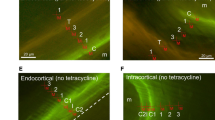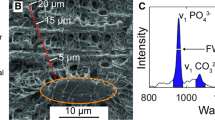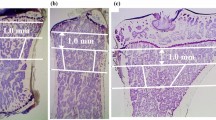Abstract
The relationship between bone turnover and bone tissue and material properties was examined in ovariectomized (OVX) rats treated with risedronate in combination with or without vitamin K2. Seventy female rats, 18 weeks of age, were assigned to 7 groups (n = 10): sham-operated + vehicle control; OVX + vehicle control; OVX + risedronate 0.1, 0.5, or 2.5 mg/kg/day po; OVX + vitamin K2 ∼30 mg/kg/day po; OVX + vitamin K2 (∼30 mg/kg/day) and risedronate (0.5 mg/kg/day). Treatments were given daily for 9 months. To assess bone turnover, we measured serum osteocalcin and urinary deoxypyridinoline at 0, 3, and 9 months. To assess vertebral and femoral tissue and material properties, bone mass, bone mineral density (BMD by DXA), trabecular bone structure (vertebra: 3D-μCT), cortical bone structure (femur: histomorphometry), biomechanical properties, and mineral properties (mineral-to-matrix and carbonate-to-phosphate ratios by Fourier transform infrared microspectroscopy) were measured ex vivo at 9 months. Ovariectomy increased bone turnover and induced significant loss of bone mass/density, structure, mineral properties (mineral-to-matrix ratio), and strength. Risedronate produced dose-dependent inhibition of the ovariectomy-induced increase in turnover and loss of bone mass/density, structure, mineral-to-matrix ratio, and strength, with a lowest effective dose of 0.1–0.5 mg/kg/day. High-dose risedronate (2.5 mg/kg/day) did not induce increases in any parameter above that of sham control. Vitamin K2 had no effects. In the OVX groups, urinary deoxypyridinoline at 3 and 9 months correlated significantly with vertebral BMD, trabecular bone volume, ultimate load, stiffness, and mineral-to-matrix ratio, and with femoral BMD, cortical area, and ultimate load. These results support the concept that changes in bone tissue and material properties can result directly from changes in bone turnover. Different effects among different drugs on material properties, including mineral-to-matrix ratio, may reflect differences in the relative rate and magnitude of osteoclastic bone resorption and osteoblastic primary bone mineralization.
Similar content being viewed by others
Author information
Authors and Affiliations
Corresponding author
About this article
Cite this article
Otomo, H., Sakai, A., Ikeda, S. et al. Regulation of mineral-to-matrix ratio of lumbar trabecular bone in ovariectomized rats treated with risedronate in combination with or without vitamin K2 . J Bone Miner Metab 22, 404–414 (2004). https://doi.org/10.1007/s00774-004-0502-6
Received:
Accepted:
Issue Date:
DOI: https://doi.org/10.1007/s00774-004-0502-6




